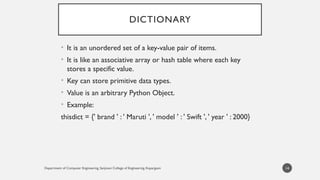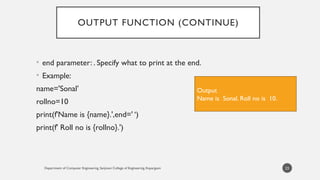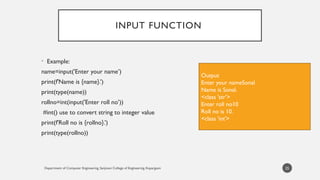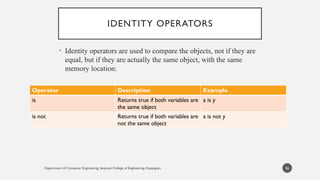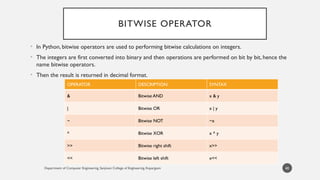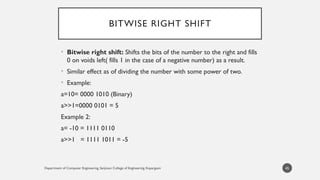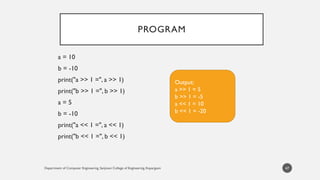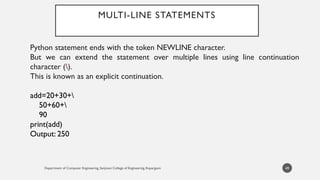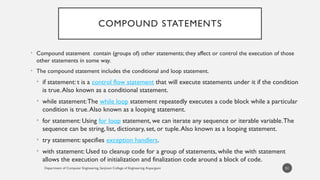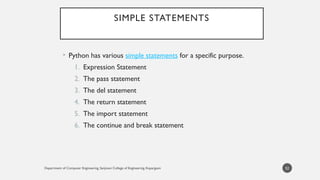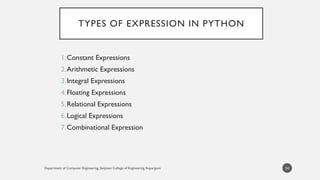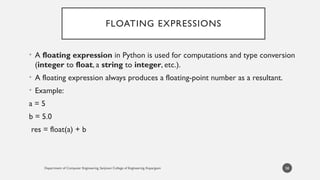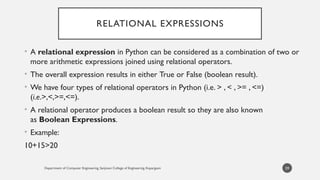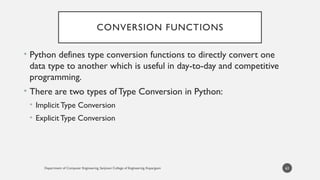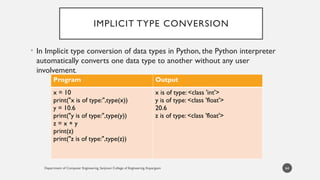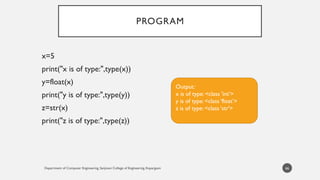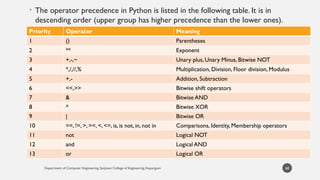Unit 1- Python- Features, Variables, Data Types, Operators and Expressions
- 1. ESIT135: PROBLEM SOLVING USING PYTHON By, Ms. Swapnali S. Gawali, Asst. Prof. Computer Engineering Sanjivani College of Engineering, Kopargaon Sanjivani Rural Education Society’s Sanjivani College of Engineering, Kopargaon-423 603 Department of Computer Engineering
- 2. UNIT-I CONTENT Department of Computer Engineering, Sanjivani College of Engineering, Kopargaon 2
- 3. WHAT IS PYTHON? • Python is a popular high-level, interpreted programming language used in various applications • Python is an easy language to learn because of its simple syntax • Python can be used for simple tasks such as plotting or for more complex tasks like machine learning Department of Computer Engineering, Sanjivani College of Engineering, Kopargaon 3
- 4. Department of Computer Engineering, Sanjivani College of Engineering, Kopargaon HISTORY OF PYTHON • Created in 1990 by Guido van Rossum • Named after Monty Python • First public release in 1991 • comp.lang.python founded in 1994 • Open source from the start • Considered a scripting language, but is much more • Scalable, object oriented and functional from the beginning • Used by Google from the beginning • Increasingly popular 4
- 5. Department of Computer Engineering, Sanjivani College of Engineering, Kopargaon FEATURES OF PYTHON 5 Features of Python 1. Free and Open Source 2. Easy to code 3. Easy to Read 4. Object-Oriented Language 5. GUI Programming Support 6. High-Level Language 7. Portable 8. Easy to Debug 9. Integrated and Interpreted 10. Large Standard Library
- 6. Department of Computer Engineering, Sanjivani College of Engineering, Kopargaon VALUES • A value is one of the basic things a program work with, like letter or a number. • Example: • 2 – Integer • 42.0 – Floating Point • ‘Hello’ – String • We use variable to stored value. 6
- 7. DATA TYPE • A data type defines the type of data stored in a variable. • Python is a dynamically typed language, so we do not need to defined data types while declaring. • Data types are the classification or categorization of data items. Department of Computer Engineering, Sanjivani College of Engineering, Kopargaon 7 Data Type Numeric Integer Complex Number Float Dictionary Boolean Set Sequence Strings Tuple List
- 8. Department of Computer Engineering, Sanjivani College of Engineering, Kopargaon NUMERIC DATA TYPE • It represents data that has a numeric value. • Three Categories: • Integer: int • Float: float • Complex Number: complex • Integer: It contains negative and positive whole numbers. (without decimal or fraction) Example:101,-319,20 • Float: It is real number with floating-point. Example: 1.5,4.5,3.5 • Complex Number: It is specified as (real part)+(imaginary part)j example: -2+6j 8
- 9. Department of Computer Engineering, Sanjivani College of Engineering, Kopargaon SEQUENCE TYPE • It is the ordered collection of similar or different data types. • Sequences used to stored multiple values in an organized and efficient fashion. • Three Categories: • String: ' '," ",''' ''' • List: [ ] • Tuple: () • String: It is a collection of one or more characters put in ‘single quote’,“double quote” and ‘‘‘ Triple quote”’ 9
- 10. Department of Computer Engineering, Sanjivani College of Engineering, Kopargaon CONTINUE.. • List: It is like a array, which is ordered collection of data. • It contains data of different types. • The items are separated by comma(,) and enclosed with in square bracket[]. • Example:A list = [1,2,3,4,5,6] fruit=["Apple", "mango", "banana"] 10
- 11. Department of Computer Engineering, Sanjivani College of Engineering, Kopargaon CONTINUE.. • Tuple: It is Like list, it also contains data of different types. The items are separated by comma(,) and enclosed with in square bracket(). • Tuple is immutable. • Example: fruit=("Apple", "mango", "banana") tuple= (1,2,3,4,5) 11
- 12. Department of Computer Engineering, Sanjivani College of Engineering, Kopargaon BOOLEAN • It provides two built in values,True and False. • It determine the given value is true or false. • It is denoted by class ' bool '. • It also represented by ' 0 ' or ' 1 ' Example: print(11>9) a=200, b=33 print(a<b) 12
- 13. Department of Computer Engineering, Sanjivani College of Engineering, Kopargaon SET • It is unordered collection of the data type. • It is iterable, mutable and has unique elements. • In it order of element is undefined. • It is created by using built-in set() function, or a sequence of elements is passed in curly braces and separated by comma. • Example: my_set = {1,2,3} myset = {1.0, ' Hi ', (1,2,3,4)} 13
- 14. Department of Computer Engineering, Sanjivani College of Engineering, Kopargaon DICTIONARY • It is an unordered set of a key-value pair of items. • It is like an associative array or hash table where each key stores a specific value. • Key can store primitive data types. • Value is an arbitrary Python Object. • Example: thisdict = {' brand ' : ' Maruti ', ' model ' : ' Swift ', ' year ' : 2000} 14
- 15. Department of Computer Engineering, Sanjivani College of Engineering, Kopargaon VARIABLES • Variables are containers for storing data values. • Unlike other programming languages, Python has no command for declaring a variable. • A variable is created the moment we first assign a value to it. • x = 5 y = "John" print(x) 5 print(y) John • Variables do not need to be declared with any particular type and can even change type after they have been set. • String variables can be declared either by using single or double quotes:‘John’ or”John” 15
- 16. Department of Computer Engineering, Sanjivani College of Engineering, Kopargaon RULES FOR CREATING VARIABLES IN PYTHON • Following are rules for creating variables in Python 1.A variable name must start with a letter or the underscore character. • example: a, name, _name_ 2.A variable name cannot start with a number. • Example:This is not allowed: 12a 3.A variable name can only contain alpha-numeric characters and underscores (A-z, 0-9, and _ ). • Example: Name, a12 4.Variable names are case-sensitive (name, Name and NAME are three different variables). • Example:This A is different than a 5.The reserved words(keywords) cannot be used naming the variable. • Example:This word not allowed and, assert, break, class, continue, def, del, elif, else, except, exec, finally, for, from, global, if, import, in, is, not, or, pass, print, raise, return, try, while 16
- 17. Department of Computer Engineering, Sanjivani College of Engineering, Kopargaon BASIC INPUT/OUTPUT IN PYTHON • Input is any information provided to the program – Keyboard input – Mouse input – File input – Sensor input (microphone, camera, photo cell, etc.) • Output is any information (or effect) that a program produces: – sounds, lights, pictures, text, motion, etc. Output( on a screen, in a file, on a disk or tape, etc.) 17
- 18. Department of Computer Engineering, Sanjivani College of Engineering, Kopargaon OUTPUT FUNCTION • print(): Used to print output. • Example 1: print ('HelloWorld’) print ("Sanjivani") print('''College of Engineering''') 18 Output Hello World Sanjivani College of Engineering
- 19. OUTPUT FUNCTION (CONTINUE) • Example 2: name='Sonal’ rollno=10 print('Name is ',name) print('Roll no is ',rollno) Department of Computer Engineering, Sanjivani College of Engineering, Kopargaon 19 Output Name is Sonal Roll no is 10 Example 3: name='Sonal’ rollno=10 print('Name is ',name, 'Roll no is ',rollno) Output Name is Sonal Roll no is 10
- 20. Department of Computer Engineering, Sanjivani College of Engineering, Kopargaon OUTPUT FUNCTION (CONTINUE) • Example 4: name='Sonal’ rollno=10 print(f'Name is {name}. Roll no is {rollno}.') 20 Output Name is Sonal. Roll no is 10.
- 21. Department of Computer Engineering, Sanjivani College of Engineering, Kopargaon OUTPUT FUNCTION (CONTINUE) • Syntax of print() print(object(s), sep=separator, end=end, file=file, flush=flush) 21 Parameter Description object(s) Any object, and as many as you like.Will be converted to string before printed sep='separator' Optional. Specify how to separate the objects, if there is more than one. Default is ' ' end='end' Optional. Specify what to print at the end. Default is 'n' (line feed) file Optional.An object with a write method. Default is sys.stdout flush Optional.A Boolean, specifying if the output is flushed (True) or buffered (False). Default is False
- 22. Department of Computer Engineering, Sanjivani College of Engineering, Kopargaon OUTPUT FUNCTION (CONTINUE) • sep parameter: is used to specify the separator between the strings. • Example: name='Sonal’ rollno=10 print(f'Name is {name}',f' Roll no is {rollno}',sep='.') 22 Output Name is Sonal. Roll no is 10
- 23. Department of Computer Engineering, Sanjivani College of Engineering, Kopargaon OUTPUT FUNCTION (CONTINUE) • end parameter: . Specify what to print at the end. • Example: name='Sonal’ rollno=10 print(f'Name is {name}.',end=' ‘) print(f' Roll no is {rollno}.') 23 Output Name is Sonal. Roll no is 10.
- 24. Department of Computer Engineering, Sanjivani College of Engineering, Kopargaon INPUT FUNCTION • Python input() function is used to take user input. • By default, it returns the user input in form of a string. • Syntax: input('prompt message’) • Example: name=input('Enter your name’) print(f'Name is {name}.’) print(type(name)) 24 Output Enter your nameSonal Name is Sonal.<class 'str'>
- 25. Department of Computer Engineering, Sanjivani College of Engineering, Kopargaon INPUT FUNCTION • Example: name=input('Enter your name’) print(f'Name is {name}.’) print(type(name)) rollno=int(input('Enter roll no’)) #int() use to convert string to integer value print(f'Roll no is {rollno}.’) print(type(rollno)) 25 Output Enter your nameSonal Name is Sonal. <class 'str’> Enter roll no10 Roll no is 10. <class 'int'>
- 26. Department of Computer Engineering, Sanjivani College of Engineering, Kopargaon OPERATORS AND OPERANDS • Operators:Operators are symbol used to perform operations on variables and values. • Operands: The values or variables that an operator acts on are called operands. • A sequence of operands and operators is called expression. Example: a+b-5 26 A + B - 5 Operands Operator
- 27. Department of Computer Engineering, Sanjivani College of Engineering, Kopargaon DIFFERENT OPERATOR IN PYTHON 1. Arithmetic operators 2. Assignment operators 3. Comparison operators 4. Logical operators 5. Identity operators 6. Membership operators 7. Bitwise operators 27
- 28. Department of Computer Engineering, Sanjivani College of Engineering, Kopargaon ARITHMETIC OPERATORS 1. Arithmetic operators are used with numeric values to perform common mathematical operations: 2. Assume x=10, y=5 28 Operator Name Example Output + Addition print(x+y) 15 - Subtraction print(x-y) 5 * Multiplication print(x*y) 50 / Division print(x/y) 2.0 % Modulus print(x%y) 0 ** Exponentiation print(x**y) 100000 // Floor Division x//y 2
- 29. Department of Computer Engineering, Sanjivani College of Engineering, Kopargaon PROGRAM a=10 b=20 c=a+b print(“Addition is ”,c) c=a-b print(“Subtraction is ”,c) c=a*b print(“Multiplication is ”,c) c=a/b print(“Division is ”,c) 29 Output: Addition is 30 Subtraction is -10 Multiplication is 200 Division is 0.5
- 30. Department of Computer Engineering, Sanjivani College of Engineering, Kopargaon ASSIGNMENT OPERATORS • Assignment operators are used to assign values to variables: 30 Operator Description = Assign value of right side of expression to left side operand += Add and Assign: Add right side operand with left side operand and then assign to left operand -= Subtract AND: Subtract right operand from left operand and then assign to left operand: True if both operands are equal *= Multiply AND: Multiply right operand with left operand and then assign to left operand /= Divide AND: Divide left operand with right operand and then assign to left operand %= Modulus AND: Takes modulus using left and right operands and assign result to left operand //= Divide(floor) AND: Divide left operand with right operand and then assign the value(floor) to left operand **= Exponent AND: Calculate exponent(raise power) value using operands and assign value to left operand
- 31. Department of Computer Engineering, Sanjivani College of Engineering, Kopargaon PROGRAM a=10 b=20 print("a is ",a) print("b is ",b) a += 1 print("Add 1 to a ",a) b -= 1 print("Subtract 1 from b ",b) a **= 2 print("a square is ", a) 31 Output: a is 10 b is 20 Add 1 to a 11 Subtract 1 from b 19 a square is 121
- 32. Department of Computer Engineering, Sanjivani College of Engineering, Kopargaon COMPARISON OPERATORS • Comparison operators are used to compare two values: 32 Operator Name Example == Equal a==b != Not Equal a!=b > Greater than a>b < Less than a<b >= Greater than or equal to a>=b <= Less than or equal to a<=b
- 33. Department of Computer Engineering, Sanjivani College of Engineering, Kopargaon PROGRAM x=10 y=20 print(x==y) print(x!=y) print(x<y) print(x>y) print(x<=y) print(x>=y) 33 Output: False True True False True False
- 34. Department of Computer Engineering, Sanjivani College of Engineering, Kopargaon LOGICAL OPERATORS • Logical operators are used to combine conditional statements: 34 Operator Description Example and Returns True if both statements are true x<5 and x<10 or Returns True if one of the statements is true x<5 or x<4 not Reverse the result, returns False if the result is true not(x<5 and x<10)
- 35. Department of Computer Engineering, Sanjivani College of Engineering, Kopargaon PROGRAM x=10 y=20 print(x==y and x<y) print(x!=y or x>y) print(not(x<y)) 35 Output: False True False
- 36. Department of Computer Engineering, Sanjivani College of Engineering, Kopargaon IDENTITY OPERATORS • Identity operators are used to compare the objects, not if they are equal, but if they are actually the same object, with the same memory location: 36 Operator Description Example is Returns true if both variables are the same object a is y is not Returns true if both variables are not the same object a is not y
- 37. Department of Computer Engineering, Sanjivani College of Engineering, Kopargaon PROGRAM x=10 y=10 print(x is y) print(x is not y) 37 Output: True False
- 38. Department of Computer Engineering, Sanjivani College of Engineering, Kopargaon MEMBERSHIP OPERATORS • Membership operators are used to test if a sequence is presented in an object: 38 Operator Description Example in Returns True if a sequence with the specified value is present in the object a in b not in Returns True if a sequence with the specified value is not present in the object a not in b
- 39. Department of Computer Engineering, Sanjivani College of Engineering, Kopargaon PROGRAM x='sanjivani’ print('s' in x) print('s' not in x) print('S' in x) print('S' not in x) y='anji’ print(y in x) print(x in y) 39 Output: True False False True True False
- 40. Department of Computer Engineering, Sanjivani College of Engineering, Kopargaon BITWISE OPERATOR • In Python, bitwise operators are used to performing bitwise calculations on integers. • The integers are first converted into binary and then operations are performed on bit by bit, hence the name bitwise operators. • Then the result is returned in decimal format. 40 OPERATOR DESCRIPTION SYNTAX & Bitwise AND x & y | Bitwise OR x | y ~ Bitwise NOT ~x ^ Bitwise XOR x ^ y >> Bitwise right shift x>> << Bitwise left shift x<<
- 41. Department of Computer Engineering, Sanjivani College of Engineering, Kopargaon BITWISE AND OPERATOR • Bitwise AND operator Returns 1 if both the bits are 1 else 0. • Example: a=10= 1010 (Binary) b=4=0100 (Binary) a&b = 1010 & 0100 =0000(Binary) =0 (Decimal) 41
- 42. Department of Computer Engineering, Sanjivani College of Engineering, Kopargaon BITWISE OR OPERATOR • Bitwise or operator Returns 1 if either of the bit is 1 else 0. • Example: a=10= 1010 (Binary) b=4=0100 (Binary) A|b = 1010 | 0100 =1110(Binary) =14 (Decimal) 42
- 43. Department of Computer Engineering, Sanjivani College of Engineering, Kopargaon BITWISE XOR OPERATOR • Bitwise xor operator: Returns 1 if one of the bits is 1 and the other is 0 else returns false. • Example: a=10= 1010 (Binary) b=4=0100 (Binary) a^b = 1010 ^ 0100 =1110(Binary) =14 (Decimal) 43
- 44. Department of Computer Engineering, Sanjivani College of Engineering, Kopargaon PROGRAM a = 10 b = 4 print("a & b =", a & b) print("a | b =", a | b) print("a ^ b =", a ^ b) 44 Output: a & b = 0 a | b = 14 a ^ b = 14
- 45. Department of Computer Engineering, Sanjivani College of Engineering, Kopargaon BITWISE RIGHT SHIFT • Bitwise right shift: Shifts the bits of the number to the right and fills 0 on voids left( fills 1 in the case of a negative number) as a result. • Similar effect as of dividing the number with some power of two. • Example: a=10= 0000 1010 (Binary) a>>1=0000 0101 = 5 Example 2: a= -10 = 1111 0110 a>>1 = 1111 1011 = -5 45
- 46. Department of Computer Engineering, Sanjivani College of Engineering, Kopargaon BITWISE LEFT SHIFT • Bitwise left shift: Shifts the bits of the number to the left and fills 0 on voids right as a result. • Similar effect as of multiplying the number with some power of two. • Example: a=10= 0000 1010 (Binary) A<<1= 0001 0100 = 20 Example 2: a= -10 = 1111 0110 A<<1 = 1110 1100 = -20 46
- 47. Department of Computer Engineering, Sanjivani College of Engineering, Kopargaon PROGRAM a = 10 b = -10 print("a >> 1 =", a >> 1) print("b >> 1 =", b >> 1) a = 5 b = -10 print("a << 1 =", a << 1) print("b << 1 =", b << 1) 47 Output: a >> 1 = 5 b >> 1 = -5 a << 1 = 10 b << 1 = -20
- 48. STATEMENT • A statement is an instruction that the Python interpreter can execute. • Python statement ends with the token NEWLINE character. It means each line in a Python script is a statement. • There are mainly four types of statements in Python, • print statements: print(“hello”) • Assignment statements: a=100 • Conditional statements: if (a>10): Print(“a is greater than 10”) • Looping statements.: for x in range(6): print(x) Department of Computer Engineering, Sanjivani College of Engineering, Kopargaon 48
- 49. Department of Computer Engineering, Sanjivani College of Engineering, Kopargaon MULTI-LINE STATEMENTS Python statement ends with the token NEWLINE character. But we can extend the statement over multiple lines using line continuation character (). This is known as an explicit continuation. add=20+30+ 50+60+ 90 print(add) Output: 250 49
- 50. Department of Computer Engineering, Sanjivani College of Engineering, Kopargaon IMPLICIT CONTINUATION: We can use parentheses () to write a multi-line statement. We can add a line continuation statement inside it. Whatever we add inside a parentheses () will treat as a single statement even it is placed on multiple lines. addition = (10 + 20 + 30 + 40 + 50 + 60 + 70) print(addition) # Output: 280 50
- 51. Department of Computer Engineering, Sanjivani College of Engineering, Kopargaon COMPOUND STATEMENTS • Compound statement contain (groups of) other statements; they affect or control the execution of those other statements in some way. • The compound statement includes the conditional and loop statement. • if statement: t is a control flow statement that will execute statements under it if the condition is true.Also known as a conditional statement. • while statement:The while loop statement repeatedly executes a code block while a particular condition is true.Also known as a looping statement. • for statement: Using for loop statement, we can iterate any sequence or iterable variable.The sequence can be string, list, dictionary, set, or tuple.Also known as a looping statement. • try statement: specifies exception handlers. • with statement: Used to cleanup code for a group of statements, while the with statement allows the execution of initialization and finalization code around a block of code. 51
- 52. Department of Computer Engineering, Sanjivani College of Engineering, Kopargaon SIMPLE STATEMENTS • Python has various simple statements for a specific purpose. 1. Expression Statement 2. The pass statement 3. The del statement 4. The return statement 5. The import statement 6. The continue and break statement 52
- 53. EXPRESSION IN PYTHON • A combination of operands and operators is called an expression. • The expression in Python produces some value or result after being interpreted by the Python interpreter. • Example: r = a+b res =10+a result = 20+30 • An expression in Python can contain identifiers, operators, and operands. • An identifier is a name that is used to define and identify a class, variable, or function in Python. Department of Computer Engineering, Sanjivani College of Engineering, Kopargaon 53
- 54. Department of Computer Engineering, Sanjivani College of Engineering, Kopargaon TYPES OF EXPRESSION IN PYTHON 1.Constant Expressions 2.Arithmetic Expressions 3.Integral Expressions 4.Floating Expressions 5.Relational Expressions 6.Logical Expressions 7.Combinational Expression 54
- 55. Department of Computer Engineering, Sanjivani College of Engineering, Kopargaon CONSTANT EXPRESSION • A constant expression in Python that contains only constant values is known as a constant expression. • In a constant expression in Python, the operator(s) is a constant. • A constant is a value that cannot be changed after its initialization. • Example: a = 20 +10 55
- 56. Department of Computer Engineering, Sanjivani College of Engineering, Kopargaon ARITHMETIC EXPRESSION • An expression in Python that contains a combination of arithmetic operators, operands, and sometimes parenthesis is known as an arithmetic expression. • The result of an arithmetic expression is also a numeric value • Example: x = c+d x = c * a 56
- 57. Department of Computer Engineering, Sanjivani College of Engineering, Kopargaon INTEGRAL EXPRESSIONS • An integral expression in Python is used for computations and type conversion (integer to float, a string to integer, etc.). • An integral expression always produces an integer value as a resultant. • Example: a = 5 b = 5.0 res = a + int(b) 57
- 58. Department of Computer Engineering, Sanjivani College of Engineering, Kopargaon FLOATING EXPRESSIONS • A floating expression in Python is used for computations and type conversion (integer to float, a string to integer, etc.). • A floating expression always produces a floating-point number as a resultant. • Example: a = 5 b = 5.0 res = float(a) + b 58
- 59. Department of Computer Engineering, Sanjivani College of Engineering, Kopargaon RELATIONAL EXPRESSIONS • A relational expression in Python can be considered as a combination of two or more arithmetic expressions joined using relational operators. • The overall expression results in either True or False (boolean result). • We have four types of relational operators in Python (i.e. > , < , >= , <=) (i.e.>,<,>=,<=). • A relational operator produces a boolean result so they are also known as Boolean Expressions. • Example: 10+15>20 59
- 60. Department of Computer Engineering, Sanjivani College of Engineering, Kopargaon LOGICAL EXPRESSIONS • As the name suggests, a logical expression performs the logical computation using logical operators, and the overall expression results in either True or False (boolean result). • Example: a and b a or b a not b a=3 b=3 if a>0 and b>0: print(“a and b greater than zero”) 60
- 61. Department of Computer Engineering, Sanjivani College of Engineering, Kopargaon COMBINATIONAL EXPRESSIONS • As the name suggests, a combination expression can contain a single or multiple expressions which result in an integer or boolean value depending upon the expressions involved. • Example: x = 5 y = 5 res = x + (2 *6) 61
- 62. Department of Computer Engineering, Sanjivani College of Engineering, Kopargaon BOOLEAN EXPRESSIONS • A boolean expression is an expression that is either true or false. • Example: 5 > 3 True 5 >9 False 62
- 63. Department of Computer Engineering, Sanjivani College of Engineering, Kopargaon CONVERSION FUNCTIONS • Python defines type conversion functions to directly convert one data type to another which is useful in day-to-day and competitive programming. • There are two types ofType Conversion in Python: • Implicit Type Conversion • Explicit Type Conversion 63
- 64. Department of Computer Engineering, Sanjivani College of Engineering, Kopargaon IMPLICIT TYPE CONVERSION • In Implicit type conversion of data types in Python, the Python interpreter automatically converts one data type to another without any user involvement. 64 Program Output x = 10 print("x is of type:",type(x)) y = 10.6 print("y is of type:",type(y)) z = x + y print(z) print("z is of type:",type(z)) x is of type: <class 'int'> y is of type: <class 'float'> 20.6 z is of type: <class 'float'>
- 65. EXPLICIT TYPE CONVERSION 1.int(a, base): This function converts any data type to integer. ‘Base’ specifies the base in which string is if the data type is a string. 2.float(): This function is used to convert any data type to a floating- point number. 3.tuple() : This function is used to convert to a tuple. 4.set() : This function returns the type after converting to set. 5.list() : This function is used to convert any data type to a list type. 6.dict() : This function is used to convert a tuple of order (key,value) into a dictionary. 7.str() : Used to convert integer into a string. 8.complex(real,imag) : This function converts real numbers to complex(real,imag) number. Department of Computer Engineering, Sanjivani College of Engineering, Kopargaon 65 In Explicit Type Conversion in Python, the data type is manually changed by the user as per their requirement. Various forms of explicit type conversion are explained below:
- 66. Department of Computer Engineering, Sanjivani College of Engineering, Kopargaon PROGRAM x=5 print("x is of type:",type(x)) y=float(x) print("y is of type:",type(y)) z=str(x) print("z is of type:",type(z)) 66 Output: x is of type: <class 'int’> y is of type: <class ‘float’> z is of type: <class ‘str'>
- 67. Department of Computer Engineering, Sanjivani College of Engineering, Kopargaon PRECEDENCE OF OPERATORS Solve this : 3 + 4 x 2 – 1 3 + 4 / 2 – 1 • BIDMAS • BIDMAS, which stands for Brackets, Indices, Division, Multiplication, Addition and Subtraction. 67
- 68. Department of Computer Engineering, Sanjivani College of Engineering, Kopargaon • The operator precedence in Python is listed in the following table. It is in descending order (upper group has higher precedence than the lower ones). 68 Priority Operator Meaning 1 () Parentheses 2 ** Exponent 3 +,-,~ Unary plus, Unary Minus, Bitwise NOT 4 *,/,//,% Multiplication, Division, Floor division, Modulus 5 +,- Addition, Subtraction 6 <<,>> Bitwise shift operators 7 & Bitwise AND 8 ^ Bitwise XOR 9 | Bitwise OR 10 ==, !=, >, >=, <, <=, is, is not, in, not in Comparisons, Identity, Membership operators 11 not Logical NOT 12 and Logical AND 13 or Logical OR
- 69. Department of Computer Engineering, Sanjivani College of Engineering, Kopargaon THANK YOU.. 69
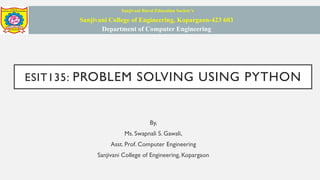
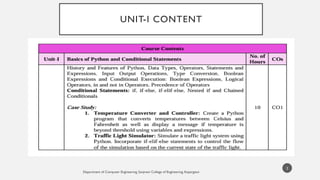






![Department of Computer Engineering, Sanjivani College of Engineering, Kopargaon
SEQUENCE TYPE
• It is the ordered collection of similar or different data
types.
• Sequences used to stored multiple values in an organized
and efficient fashion.
• Three Categories:
• String: ' '," ",''' '''
• List: [ ]
• Tuple: ()
• String: It is a collection of one or more characters put in
‘single quote’,“double quote” and ‘‘‘ Triple quote”’
9](https://image.slidesharecdn.com/unit1-250321183450-660231a4/85/Unit-1-Python-Features-Variables-Data-Types-Operators-and-Expressions-9-320.jpg)
![Department of Computer Engineering, Sanjivani College of Engineering, Kopargaon
CONTINUE..
• List: It is like a array, which is ordered collection of data.
• It contains data of different types.
• The items are separated by comma(,) and enclosed with
in square bracket[].
• Example:A
list = [1,2,3,4,5,6]
fruit=["Apple", "mango", "banana"]
10](https://image.slidesharecdn.com/unit1-250321183450-660231a4/85/Unit-1-Python-Features-Variables-Data-Types-Operators-and-Expressions-10-320.jpg)



